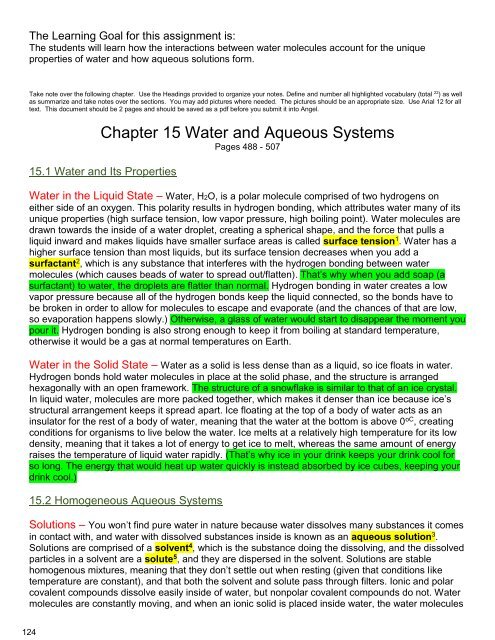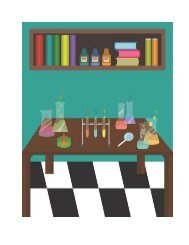(FINAL) Chemistry Notebook 2016-17
- No tags were found...
You also want an ePaper? Increase the reach of your titles
YUMPU automatically turns print PDFs into web optimized ePapers that Google loves.
The Learning Goal for this assignment is:<br />
The students will learn how the interactions between water molecules account for the unique<br />
properties of water and how aqueous solutions form.<br />
Take note over the following chapter. Use the Headings provided to organize your notes. Define and number all highlighted vocabulary (total 22 ) as well<br />
as summarize and take notes over the sections. You may add pictures where needed. The pictures should be an appropriate size. Use Arial 12 for all<br />
text. This document should be 2 pages and should be saved as a pdf before you submit it into Angel.<br />
Chapter 15 Water and Aqueous Systems<br />
Pages 488 - 507<br />
15.1 Water and Its Properties<br />
Water in the Liquid State – Water, H2O, is a polar molecule comprised of two hydrogens on<br />
either side of an oxygen. This polarity results in hydrogen bonding, which attributes water many of its<br />
unique properties (high surface tension, low vapor pressure, high boiling point). Water molecules are<br />
drawn towards the inside of a water droplet, creating a spherical shape, and the force that pulls a<br />
liquid inward and makes liquids have smaller surface areas is called surface tension 1 . Water has a<br />
higher surface tension than most liquids, but its surface tension decreases when you add a<br />
surfactant 2 , which is any substance that interferes with the hydrogen bonding between water<br />
molecules (which causes beads of water to spread out/flatten). That’s why when you add soap (a<br />
surfactant) to water, the droplets are flatter than normal. Hydrogen bonding in water creates a low<br />
vapor pressure because all of the hydrogen bonds keep the liquid connected, so the bonds have to<br />
be broken in order to allow for molecules to escape and evaporate (and the chances of that are low,<br />
so evaporation happens slowly.) Otherwise, a glass of water would start to disappear the moment you<br />
pour it. Hydrogen bonding is also strong enough to keep it from boiling at standard temperature,<br />
otherwise it would be a gas at normal temperatures on Earth.<br />
Water in the Solid State – Water as a solid is less dense than as a liquid, so ice floats in water.<br />
Hydrogen bonds hold water molecules in place at the solid phase, and the structure is arranged<br />
hexagonally with an open framework. The structure of a snowflake is similar to that of an ice crystal.<br />
In liquid water, molecules are more packed together, which makes it denser than ice because ice’s<br />
structural arrangement keeps it spread apart. Ice floating at the top of a body of water acts as an<br />
insulator for the rest of a body of water, meaning that the water at the bottom is above 0 oC , creating<br />
conditions for organisms to live below the water. Ice melts at a relatively high temperature for its low<br />
density, meaning that it takes a lot of energy to get ice to melt, whereas the same amount of energy<br />
raises the temperature of liquid water rapidly. (That’s why ice in your drink keeps your drink cool for<br />
so long. The energy that would heat up water quickly is instead absorbed by ice cubes, keeping your<br />
drink cool.)<br />
15.2 Homogeneous Aqueous Systems<br />
Solutions – You won’t find pure water in nature because water dissolves many substances it comes<br />
in contact with, and water with dissolved substances inside is known as an aqueous solution 3 .<br />
Solutions are comprised of a solvent 4 , which is the substance doing the dissolving, and the dissolved<br />
particles in a solvent are a solute 5 , and they are dispersed in the solvent. Solutions are stable<br />
homogenous mixtures, meaning that they don’t settle out when resting (given that conditions like<br />
temperature are constant), and that both the solvent and solute pass through filters. Ionic and polar<br />
covalent compounds dissolve easily inside of water, but nonpolar covalent compounds do not. Water<br />
molecules are constantly moving, and when an ionic solid is placed inside water, the water molecules<br />
124





